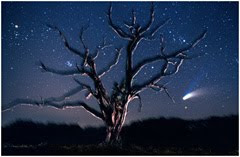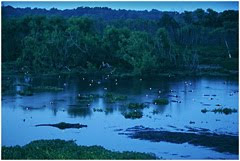BC3 Assignment #3: Think Big
 The subject for assignment #2 was nice and small in size; very manageable. This will not be the case for assignment #3.
The subject for assignment #2 was nice and small in size; very manageable. This will not be the case for assignment #3.
In fact, the subject for this assignment will almost certainly be too big to light completely with your small flashes.
__________
Assignment #3
For BC3.3 you will be required to photograph an outdoor space or scene, with the idea being to evoke a sense of place. And since you cannot control the lighting over a large area with a couple of speedlights, you'll have to wait for the right quality of ambient light to come to you.
With the ambient doing the heavy lifting (and, more important, creating the mood) you'll find it much easier to finish off the scene with one or two speedlights.
But first, you'll need to select a subject. It should be within your immediate community, and something you find both interesting and appropriate. You may already have a place in mind that you had been wanting to photograph. Or you might want to take a quick drive or walk to scout some options. But I would nail down your subject pretty quickly.
Once you have decided what you want to shoot, you'll want to decide what time of day will work best for your photo. Broad daylight is easy enough, but generally not the best time to make an evocative photo of an outdoor space. Sunlight is the default -- the way we are used to seeing things.
Sunset might work better. Or twilight. Or deep dusk, when the light is beautiful, unpredictable and fleeting. Or even well before dawn. (Yeah, you heard me. Man up.)
For starters I'd suggest looking at your space on Google maps to get a good idea of the orientation. This will give you an idea of where the light will be at different times during the day or night. (And yes, the moon can be used as a key light for an outdoor photo.) Second, check out a weather forecast to see what types of ambient light modifiers Mother Nature will have on offer throughout the week.
But pick a place pretty quickly, so you can visit it at different times of the day and study it with your camera. Available light will carry a lot of weight in a photo like this, so think of the ambient as a light that you can control by merely waiting it out.
Tips for Gaining Access
If your scene is public, no problem. But you also might try to photograph something that is not as easily accessible. You'll find that a visit, email or handwritten note can go a long way towards getting access to a special place. Tell them that you have been assigned to photograph a special place for a class project and that you'd love to shoot, well, whatever it is that you are trying to shoot.
Offer to email them a photo afterwards as a gesture. I generally email a 1000 px image, which works nicely for visual detail but is not really useful for printing or print reproduction. If they really like it, they might even call you back after to buy rights to use it in some way. It has already happened to at least one boot camper this summer. Who knows.
But that's just gravy. You are primarily looking for access, and offering a small gesture to smooth the way.
Sell an Idea
As with the product shot last time, you are not just trying to make a record of a space. Aim for something evocative. Try to create a mood.
This is why you plan, and/or wait out the changes in the light. Those changes will have a profound effect on how your scene both looks and feels. The best landscape photographers (and I don't even know if landscape is the best word for this shot) are willing to get up insanely early; or work well into the night. It's basically caffeine or bug spray, or both. Take your pick.
A good friend of mine runs a semi-regular landscape photography out of San Francisco. I won't say who because he does it guerilla style, with no shooting permits, etc. But he facilitates his students taking the best landscape photos of their life with one simple setting. The setting is not even on the camera -- it's on the alarm clock. Set your clock for 3:30am and then be ready to roll your ass out of bed. You want to be in place before the light gets good.
Most helpfully, you will find very few people to deal with regarding shooting permits and the like before dawn, too. Which is how the afore-unmentioned photographer is able to skate by.
You put someone in position 20 mins before the amazing light and tell them to put their camera on the "green button" setting and that you want them to shoot 500 photos in the next 40 minutes and it is pretty difficult to fail completely. Although, to be sure, some will rise to the occasion.
Below is a great video on Todd Hido, which will show you some of the possibilities of shooting land and cityscapes during times of marginal light. It moves into available light portraiture for a few mins, but that is pretty interesting, too:
So Hido shoots all available light. But he chooses his available light very deliberately, be it shooting at night or choosing the top floor of a hotel room. Even then, he turns windows into variable light sources with cutters and scrims.
Of course, we won't be satisfied with mere available light -- even if at the magic moment -- for this particular assignment...
Lighting Tips
So here's the thing with twilight (or dusk, or nighttime) ambient: It makes stuff look very cool and different, but it also will introduce some negative space in your frame. You'll likely get very dark areas that make your images look like, well, someone who was willing to roll out of bed at oh-dark-thirty but still just shoots on green. This is because you are not Todd Hido.
Not that there's anything wrong with that. But as lighting photographers, we can control key parts of this negative space. And this is where a scouting run or two can make a huge difference, as you may not want to figure out where your ambient problems are while your light is transitional and changing quickly.
So cut yourself a little slack and nail stuff down one step at a time. Choose your location. Scout it for time-of-day variables. Maybe do a ambient shoot and see what you would like to tweak with light to make the photo more detailed or three-dimensional. Then go back and make a good photo better with just a tweak of strobe and some killer ambient.
And here's the cool part. Since you are shooting in low ambient levels, your small flash becomes an amazingly efficient light source. Especially since you are not trying to nuke the scene but rather to add a little detail somewhere, or maybe some texture. So maybe back off on the flash exposure a little. There is a whole range of tones between black and full exposure. Explore. Let your ambient work for you, and just tweak it with flash.
Think about putting your light(s) way away from the camera. Maybe place them deep into your subject and/or off to the side to create texture. You are shooting for legibility and added interest.
 The best person I know at doing this is John Moran. He's been creating evocative landscapes by layering cool ambient and small flash since I shot with him back in college. two examples that we have run here before are his shot of Comet Hale-Bopp and this beautiful shot of alligators at dusk (scroll to bottom).
The best person I know at doing this is John Moran. He's been creating evocative landscapes by layering cool ambient and small flash since I shot with him back in college. two examples that we have run here before are his shot of Comet Hale-Bopp and this beautiful shot of alligators at dusk (scroll to bottom).
 Essentially, John is beginning with a specifically chosen ambient light for the scene and then finishing it off with a little special sauce courtesy one or two small flashes. I can offer you no better compass point for this assignment.
Essentially, John is beginning with a specifically chosen ambient light for the scene and then finishing it off with a little special sauce courtesy one or two small flashes. I can offer you no better compass point for this assignment.
__________
How To Submit
The deadline is Saturday, Sept. 3rd, 1700 hours GMT. (That's noon Eastern in the US.)
Very important: When you shoot your outdoor space photo, also shoot one similar frame where you include your or someone else's hand making an "okay" sign (i.e., thumb and forefinger in a circle, other three fingers extended.) Hold onto this "code" shot but do not turn it in. If you win, you may be asked to produce this image to show that your shot was not made prior to today.
To submit your photo, you will need to be on Flickr and in the Strobist Group. Tag your photo with the tag "BC33" (do not use the quotes). Submit your photo into the Strobist group. Caption the picture with your geographic location (maybe a Google map link) and why you chose it. Also -- very important -- Be sure to include lighting information in the caption.
Enter only one photo. Please do not tag any other photos BC33 or include that word in the caption or title, so extra photos will not show up in the search.
You can see your submissions and those of others here.
If you have trouble with submitting, tagging, your photo not showing up, please reread the BC3 Introduction Post for help.
Want to discuss it? Trade ideas? Get peer feedback? The BC3.3 discussion thread is here. And to not split the discussion into two locations, I am closing comments on this post.
Remember, the winner for this assignment gets his or her choice of a Lighting in Layers Boxed DVD Set or a LumoPro LP160 speedlight.
Good luck!
__________
New to Strobist? Start here | Or jump right to Lighting 101
My new book: The Traveling Photograher's Manifesto
Permalink
<< Home